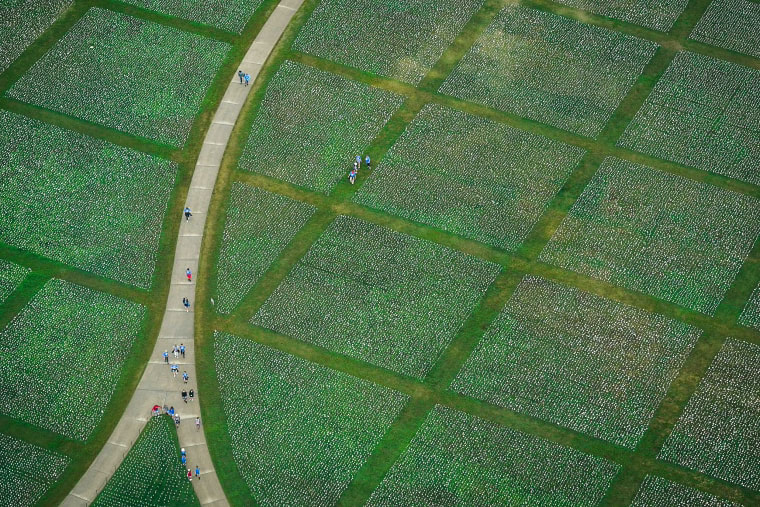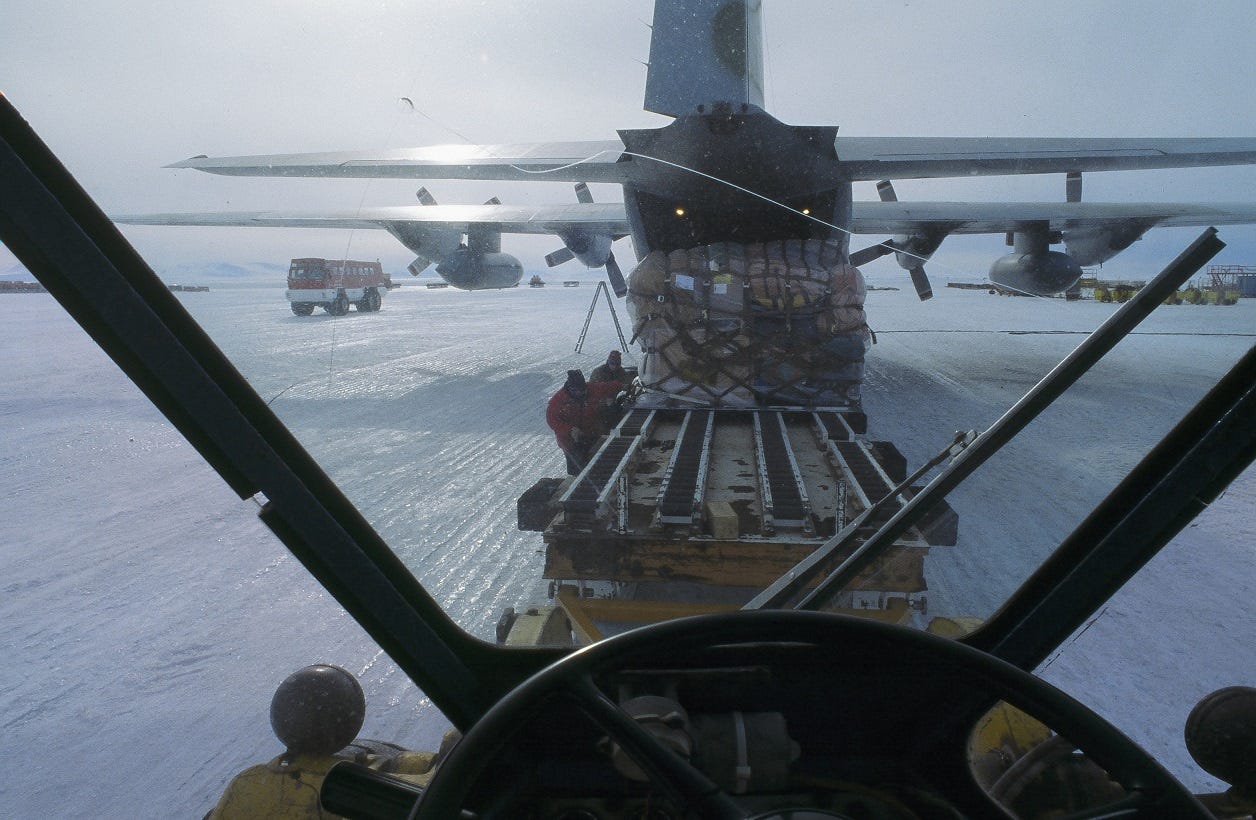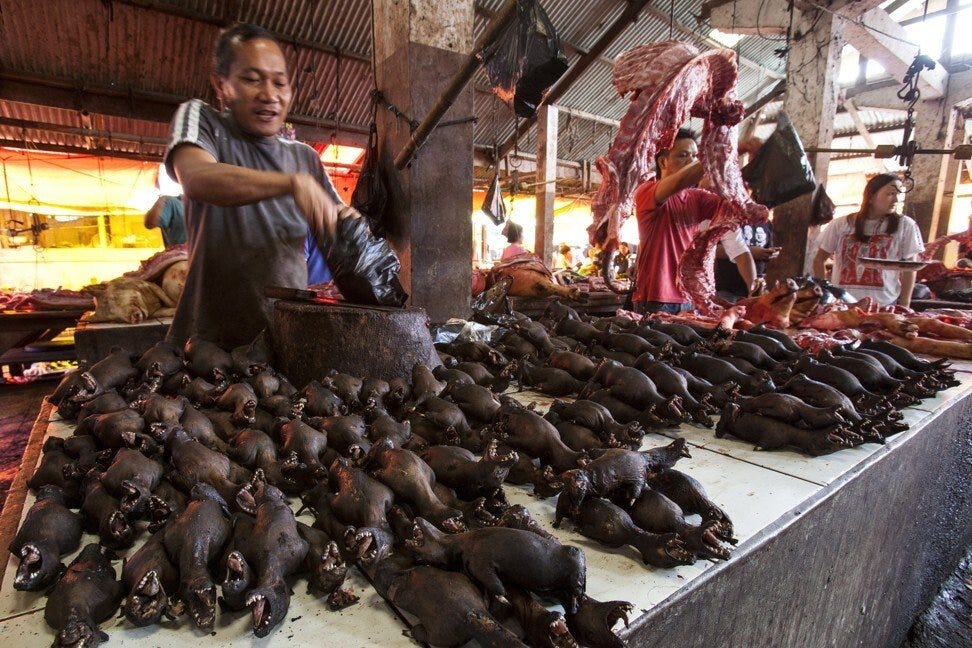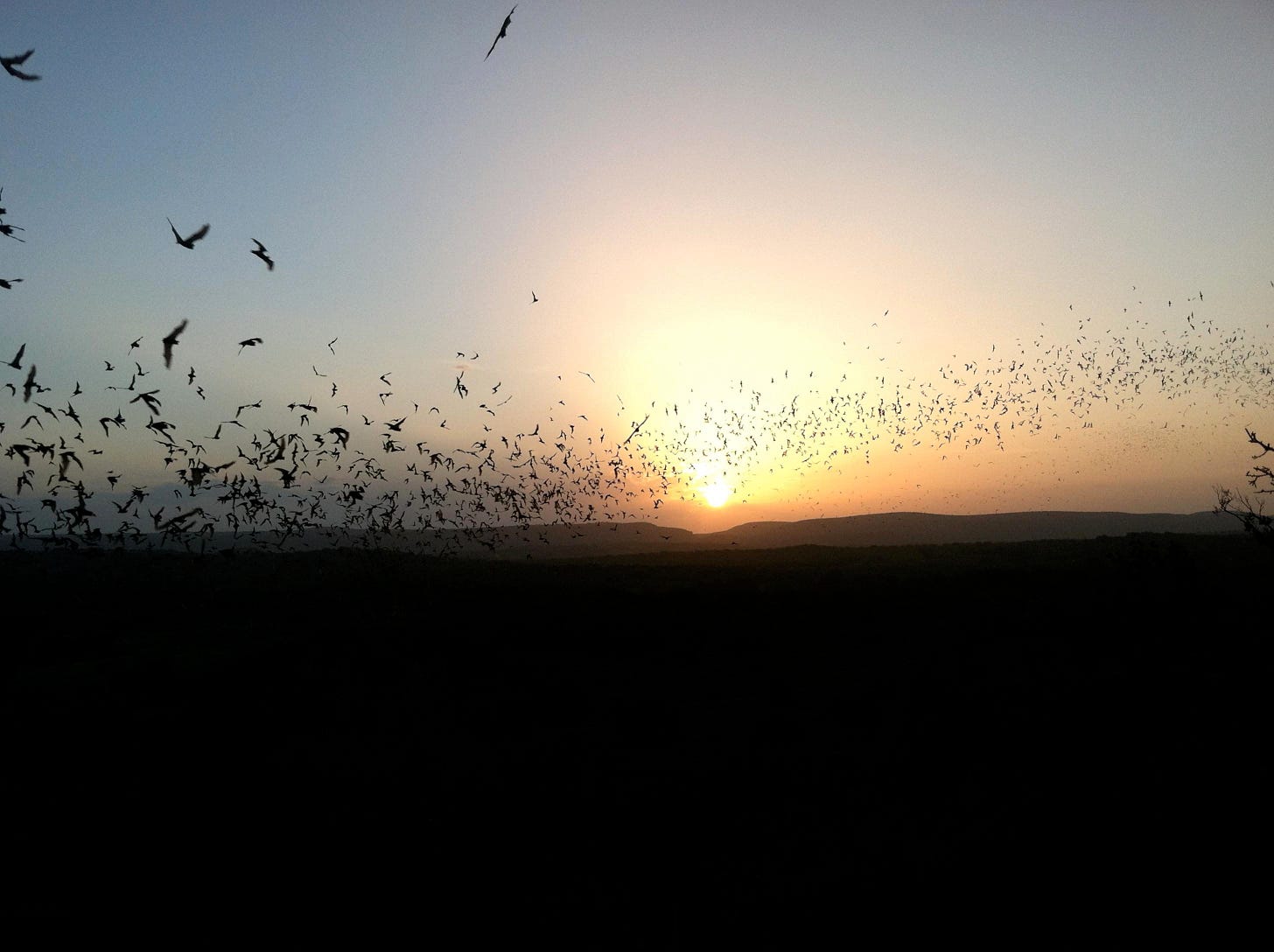Out of Tragedy, A Glimmer
5/19/22 - The Pandemic and the Anthropocene

Hello everyone:
As always, please remember to scroll past the end of the post to read this week’s curated Anthropocene news.
Now on to this week’s writing.
There’s a fair amount of reporting right now on a grim Covid pandemic milestone here in the U.S.: 1 million deaths. Often included in the reports is the grimmer global death toll of an estimated 15 million. But these are likely conservative estimates, since the pandemic has upended healthcare, governance, and societal networks to such an extent that many deaths, directly and indirectly related to Covid-19, were not recorded. The real mortality, according to analysis at the Economist (here’s an explanation at Our World in Data) may be more than 1.2 million people here in the U.S. and 25 million around the world.
One of the recent articles, an excellent illustrated New York Times piece, asks and answers the question of how the hell the U.S. lost at least a million people in the last two years. “More Americans,” the Times notes, “have died of Covid-19 than in two decades of car crashes or on battlefields in all of the country’s wars combined.”
All of the country’s wars combined… I had to look it up to believe it. U.S. military deaths in World War I, World War II, Vietnam, Korea, Afghanistan, Iraq, Syria, and elsewhere add up to fewer than 700,000 lost souls. But the Times should have specified foreign wars, since they didn’t include deaths from the Civil War, which killed about 620,000.
Combined, though, deaths from foreign and domestic conflicts add up to just over 1.3 million. If the higher estimate of U.S. Covid deaths (1.2 million) is accurate, and if we continue the current Covid death rate of 300/day, we’ll reach 1.3 million within a year. Then the mortality will match that of all the country’s wars. It’s simply astonishing, not least because it’s unclear whether the U.S. will create a permanent memorial for Covid victims that would somehow do justice to the scale of the loss.
I was about to write that this time is unique in modern history, but then I looked at the mortality from the so-called Spanish flu pandemic a century ago. Perhaps 50 million died around the world, including 675,000 Americans, but the nation’s population was less than a third of what it is today. 1 out of every 150 Americans died from the Spanish flu. So far, 1 out of every 330 citizens has died in this pandemic. There are no memorials in town squares for the victims of that Spanish flu, just as there may not be any for our neighbors and relatives and grocery clerks who died from Covid or its unraveling of the healthcare system. The ubiquity of death (which in 1919 included the dead of WWI) inures us to it, apparently, and we seem more likely to move on with our lives than harbor a national grief.
The Times quotes Mary T. Bassett, the health commissioner for New York State, as she ponders how we reached this grim and unnecessary milestone:
We are a country with the best doctors in the world, we got a vaccine in an astoundingly short period of time, and yet we’ve had so many deaths. It really should be a moment for us all to reflect on what sort of society we want to have.
Indeed. Which brings me to my subject today. The nuances of the pandemic are largely beyond the bailiwick of this Field Guide, but there’s plenty to say about what it tells us about the Anthropocene and our path forward. Here are a few of my thoughts.
We All Live in Antarctica
In Antarctica, we import everything we need to eat, work, and furnish our lives. I often marveled at the armchairs and mattresses, the volleyballs, the massive pre-cast concrete foundation blocks, the plywood and two-by-fours, the heavy machinery, and the fresh fruit that arrived by ship or plane from the warm world. It is both enormously strange and comforting to sit by a window at the South Pole with a book and an orange while gazing out at the surface of two-mile-deep ice that stretches for hundreds of miles in all directions.
Living in Antarctica is, in principle, akin to life aboard the space station as it orbits the home planet. (Though we do have the luxuries of air to breathe and ice to melt.) It’s life in a place that does not support life, which means we’re dependent on our imports. During all those years I spent on the ice, each day was a much more comfortable version of what an astronaut experiences as they float tethered to their space station, or (if we’re foolish enough to try) what future inhabitants of bases on the Moon or Mars will experience. Those “settlers” will grow some lettuce in moon soil or space-age greenhouse, but they won’t feed themselves. They’ll innovate and imagine but they won’t manufacture much of what they need to live.
But the pandemic has revealed that we don’t need to go anywhere to find the Antarctic metaphor all around us. Of course we might have already known that plastic came from global fossil fuel production, sugar for our cookies came from plantations in the Caribbean, palm oil came from jungle-killing groves in Malaysia, and electronics came from hard labor in China. But the supply chain was invisible because it ran smoothly, more or less. We didn’t pay nearly as much attention to shipping, ports, or truck drivers as we did to the cornucopia on the shelves of our local superstore.
The “global supply chain” is a euphemism for a planet-devouring trade network which the pandemic has revealed to be a house of cards. This is no longer (if it ever was) “trade” in the sense of exchanging bananas and citrus for wheat and ball bearings. It’s a culture of industrial expansion seeking to maximize profit through proselytizing economic growth, intensifying standards of living beyond what makes us either healthy or happy, and looting the natural world.
The supply chain is built entirely on fantasies of human entitlement rooted in scientific ignorance: we can burn millions of years of fossil fuels in decades without disrupting life on Earth; we can grow our population by the billions without consequence; and we can run a Ponzi scheme of constant economic growth within a fever dream that tells us that the Earth’s supply of resources is endless.
We all rely on a constant influx of material and products from very far away. Look away from the screen for a moment and scan the room you’re in. What percentage of things around you are truly local? What percentage is made up of objects whose materials, added together, traveled tens of thousands of miles? The bulk of our food, goods, and services arrive with a low price but an enormous cost. The nature of consumer culture means that our attention to that process seems about as sophisticated as believing that babies are delivered by storks.
The pandemic (with some climate-related crop failures, and now Russia’s invasion of Ukraine) profoundly disrupted the movement of even the basics: food, fertilizer, fuel, etc. We are treating this disruption as a temporary issue soon to be resolved. But this is a good civilizational moment to consider what it means for nations to be permanently dependent on imports for something as crucial as basic foodstuffs, especially as we enter a hotter, drier, farming-unfriendly, climate-addled era.
In this sense, the pandemic is something of a dry run for the far greater disruption of a warmer world. In the hard-to-imagine scenarios that play out under another degree or two of warming, a severely disrupted supply chain could easily lead to widespread famines, because as a recent piece by Jane O’Sullivan at The Overpopulation Project notes, “a deglobalised food system can’t support our current global population.”
That piece from The Overpopulation Project opens with a discussion of a 2015 Lloyds of London study that predicted the kind of mess the global food system is facing. It imagined climatic changes from a strong el Niño event which reduced global grain production and exacerbated economic and political strife in those nations less able to purchase the remaining high-priced grain. O’Sullivan explains that
a common riposte to any claim of overpopulation is that there is plenty of food produced for 8 billion people, if it were fairly distributed. But the more redistribution needed, the greater the vulnerability. The steady divergence between the places where population is growing most and the places with capacity to increase food production builds a tension that can easily snap.
When everyone is living at least partially in Antarctica, home is less the ground you stand on and more the lifelines you rely on.

Just a Tragic Blip
Bear with me for a moment while I treat the 15 to 25 million Covid-19 deaths around the world as statistics rather than a tragedy of real lives lost amid the upending of families and communities. As I’ve noted in previous population essays here and here, the population growth rate in recent years has been about 2.6 babies per second. That’s 200,000 per day and a million every five days. It’s a Germany of babies (about 80 million) per year. To be clear, this is the net gain – births minus deaths – of humans in this era.
From a simple numerical perspective, then, the 15 to 25 million deaths represent only 75 to 125 days of lost growth rather than a population reduction. Noting also that the majority of the dead were older – see in the chart above that adults 65 and older made up nearly three-fourths of the dead here in the U.S. – there seems not to have been a significant decline in children or adults who plan on raising a family. Whether the economic chaos and psychological turmoil of the pandemic has dampened the desire or reduced the capacity of young adults to raise a family is another question, one that hasn’t been properly answered yet.
Knowledge Without Action is Not Power
“It's not healthy nature that causes pandemics,” says David Attenborough in the 2021 Planetary Boundaries documentary on Netflix. That documentary and the planetary boundaries concept, which I’ve written about extensively, tries desperately to drive home the concept that human health and environmental health are linked so fundamentally that our destruction of the natural world is simultaneously a form of self-destruction.
This is as obvious to ecologists as the value of compound interest is to economists, but no one listens to ecologists. Though they are little more than speculative fictions, economies have largely replaced ecologies at the center of human culture.
An important, if disturbing, 2021 paper from some of the world’s top ecologists (I’ve written about this “Ghastly report” before) described the Covid outbreak as “the emergence of a long-predicted pandemic.” The context for both the viral outbreak and the ecologists’ expectation of its arrival is what we call the Anthropocene. The constant grinding loss of forests, grasslands, wetlands, and rainforests beneath the bulldozers and chainsaws can only lead to more degradation and chaos. Specifically, the destruction of rich, biodiverse tropical forests radically increases our risk of encountering and spreading new pathogens. Our unbalanced exploitation of the natural world “is degrading both human health and wealth,” the authors point out. Three-fourths of new infectious diseases result from human-animal interactions, and thus
environmental degradation via climate change, deforestation, intensive farming, bushmeat hunting, and an exploding wildlife trade mean that the opportunities for pathogen-transferring interactions are high. That much of this degradation is occurring in Biodiversity Hotspots where pathogen diversity is also highest, but where institutional capacity is weakest, further increases the risk of pathogen release and spread.
To say the pandemic was not a surprise is an understatement. For decades, a long list of books, scientific studies, conferences, and government documents mapped out likely pandemic scenarios. Experts pegged the family of coronaviruses as a likely suspect. National Geographic had a good article on this in 2020 by Robin Marantz Henig, who wrote the 1990 book A Dancing Matrix:
I wrote about how experts were identifying conditions that could lead to the introduction of new, potentially devastating pathogens – climate change, massive urbanization, the proximity of humans to farm or forest animals that serve as viral reservoirs – with the worldwide spread of those microbes accelerated by war, the global economy, and international air travel. Too many of us, I wrote, were blithely going about our business despite the growing threat. Sound familiar?
It still sounds familiar, not least because we’re watching in real time as citizens and politicians focus on “moving on” from the pandemic. Funding is harder to come by. The weird amnesia that seems intuitive in humans may well keep us from being prepared for the next outbreak. After all, how many of you learned in school about the utter devastation of the Spanish flu?
This Was a Drill
For much of the pandemic the mindset for anyone paying attention was This is not a drill. This was the real deal: a rapidly-spreading and rapidly-mutating global disease, brought on by an expanding human population devouring the Earth’s resources so intensely that new pathogens are popping up out of the dense forests that lay devastated at our feet.
But, really, this was a drill. Sure, life was upended in human communities around the planet. Families lost loved ones in numbers we haven’t seen since the last global pandemic or the world wars. Trade networks and confidence in political leadership took their lumps in equal measure. But the pandemic could easily have been much, much worse. The related coronaviruses behind the SARS and MERS epidemics had case fatality rates of 10% and 34%, respectively, far deadlier than the 1% to 2% rate of Covid-19. Imagine a tenth to a third of infections being fatal.Imagine that disease racing along our global trade networks.
Also, as I noted above, if we don’t surpass all expectations and get a firm handle on greenhouse gas emissions immediately to reduce 21st century warming to 1.5°C, the range of scenarios that are likely to play out in a hot, stunted, conflict-ridden world may make the disruptions of this pandemic seem trifling.
Most notably, perhaps, a study came out last month which highlighted how a warming planet will send species moving to new places and interacting in new ways with other species, increasing the likelihood that viruses will spread between wild mammals and then into humans. Bats in particular will play a key role. The New York Times and SciTechDaily both have good articles on this.
Out of Tragedy, A Glimmer
Do you remember, early in the pandemic, all the news stories of sudden improvements in air quality, of the sights and sounds of wildlife filtering into the quiet of locked-down cities, of dolphins swimming in less murky Venetian canals? It was a rare positive measure of the zero-sum relationship modern civilization has formed with natural communities. As our lives briefly contracted, the natural world briefly expanded. The respite that nature got from our Anthropocene activity was immediately visible and audible. This in turn made us a bit more attuned to the real world.
The hopeful signs within all the darkness I’ve outlined here are many, but they require action. First and foremost, we have intimate knowledge of the cause and effect of these pandemics, and we largely know what to do in order to insulate humanity from the likelihood of the next one. We see the fragility of the “supply chain,” and we see its impacts on environmental and human communities. Counteracting climate change will help protect the trade networks from future calamities while also reducing the harm they cause.
The majority of us cared for each other, sacrificed for each other, loved each other, and shared stories that honored that love and willingness to sacrifice. We became, I think, more attuned to what makes a meaningful life, and less willing to stay in jobs that did not seem meaningful.
In the intro to Jason Hickel’s Less is More, his book promoting the necessity of economic degrowth, he points out a valuable lesson of the pandemic:
The coronavirus crisis made it evident that if governments are determined enough and driven enough by circumstances – and by the will of their peoples – then they can do things that they have been calling impossible for years: a citizens’ income, debt cancellation, wealth taxes, nationalisations where necessary, you name it.
Likewise, the ecologists see a glimmer of hope in our massive response to the pandemic. As David Attenborough says in the Planetary Boundaries documentary,
The appearance of Covid-19 was a clear warning that all is not well with our planet, but it has also given us an opportunity to rebuild in a new direction. Now that Johan [Rockström] and his colleagues have turned on the headlights we can clearly see the boundaries. We can see the path back to a safe space, to a more resilient future. It is achievable.
Thanks for sticking with me.
In other Anthropocene news:
From Vox, a primer on a terrible but little-known source of ocean pollution: nurdles, tiny beads of toxic petro-pollution.
Tapping into ancient groundwater: An older but excellent illustrated explainer article about our unsustainable extraction of deep groundwater, from The Conversation.
From the New Yorker, a water management crisis in California.
From Anthropocene Magazine: Want to make agriculture more climate-friendly by making the soil better at absorbing CO2? Spread rock dust.
From Yale e360, trees in a warming world will be less able to absorb carbon, according to new research. That means we probably shouldn’t plan on forests playing as large a role as we’d hoped in counteracting climate change.








Thank you Jason. I'm going to pass this along to as many as I can.
Thank you for your wisdom, Jason. You wouldn't believe what a large portion of my mental space is taken up by contemplating the issues you raise.